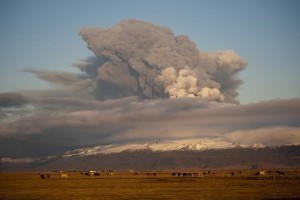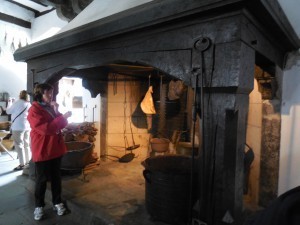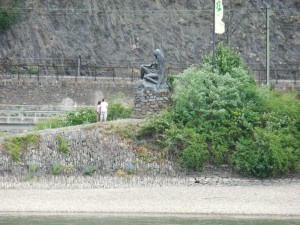Lea Wait's Blog, page 312
August 31, 2014
Tomato Salad Recipe
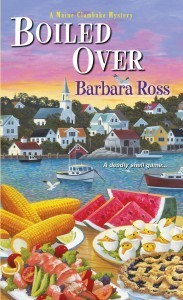 Hi. Barb here. Happy Labor Day. To celebrate the traditional end of the summer, I’m offering another recipe from Boiled Over, my second Maine Clambake Mystery. It will be especially useful for those of you who are now or will soon be overrun with garden tomatoes. My husband’s been making this recipe for years and years and it’s a huge favorite in our house. His mother also makes it, so it goes back a ways, though the two of them occasionally argue about the ingredients.
Hi. Barb here. Happy Labor Day. To celebrate the traditional end of the summer, I’m offering another recipe from Boiled Over, my second Maine Clambake Mystery. It will be especially useful for those of you who are now or will soon be overrun with garden tomatoes. My husband’s been making this recipe for years and years and it’s a huge favorite in our house. His mother also makes it, so it goes back a ways, though the two of them occasionally argue about the ingredients.
In Boiled Over, I give the recipe to Richelle Rose, one of the “guest stars” in the book. She’s a professional tour guide.
Richelle’s Tomato Salad
 Richelle Rose lives on the road giving tours throughout Maine. When she’s home, she craves simple, local food, and in the summer, that means tomato salad. The basic recipe is wonderful. Add in one or more of the options only if you happen to have the ingredient at hand or desire the taste. Because the flavor of this recipe depends so much on the taste and texture of the tomatoes, it should be made only when you have access to really good ones.
Richelle Rose lives on the road giving tours throughout Maine. When she’s home, she craves simple, local food, and in the summer, that means tomato salad. The basic recipe is wonderful. Add in one or more of the options only if you happen to have the ingredient at hand or desire the taste. Because the flavor of this recipe depends so much on the taste and texture of the tomatoes, it should be made only when you have access to really good ones.
Ingredients
4 large tomatoes
1-2 cloves garlic
kosher salt
1/2 teaspoon dried oregano
Options
red onion, chopped or sliced
cucumber, seeded and diced
oregano, fresh
basil, fresh
8-12 ounces bocconcini (mozzarella bites) or other fresh mozzarella
 Core tomatoes and slice into bite-sized chunks. Layer tomatoes in serving bowl, salting each layer with kosher salt. Mince garlic and toss with tomatoes. Add any other optional ingredients. Cover bowl and marinate at room temperature for 1-2 hours, stirring occasionally. May be served chilled or at room temperature. Also makes a wonderful fresh sauce for pasta. Serves 4.
Core tomatoes and slice into bite-sized chunks. Layer tomatoes in serving bowl, salting each layer with kosher salt. Mince garlic and toss with tomatoes. Add any other optional ingredients. Cover bowl and marinate at room temperature for 1-2 hours, stirring occasionally. May be served chilled or at room temperature. Also makes a wonderful fresh sauce for pasta. Serves 4.
Enjoy and happy Labor Day!
August 29, 2014
Weekend Update: August 30-31, 2014
 Next week at Maine Crime Writers there will be posts by Barbara Ross (Monday), John Clark (Tuesday), Sarah Graves (Wednesday), Kate Flora (Thursday), and Kaitlyn Dunnett (Friday).
Next week at Maine Crime Writers there will be posts by Barbara Ross (Monday), John Clark (Tuesday), Sarah Graves (Wednesday), Kate Flora (Thursday), and Kaitlyn Dunnett (Friday).
In the news department, here’s what’s happening with some of us who blog regularly at Maine Crime Writers:
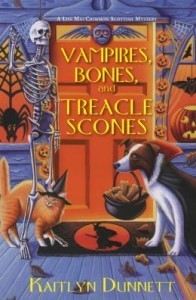 from Kaitlyn Dunnett: Tuesday, September 2nd, is the release date for the paperback reprint of the 7th Liss MacCrimmon mystery, Vampires, Bones, and Treacle Scones, the one set at Halloween in Moosetookalook, Maine. The next new hardcover (Ho-Ho-Homicide) is a Christmas book, so it won’t hit stores until the end of October. Meanwhile, I’ve sent back the copy-edits for Murder in the Queen’s Wardrobe (March 2015 pub date, w/a Kathy Lynn Emerson) and turned in the 9th Liss, tentatively titled The Scottie Barked at Midnight. That one will be out in about a year. Time now to take a deep breath. Then it’s back to work on the proposal for the 10th Liss MacCrimmon (“a reasonably detailed outline” due in December) and on turning the second book in the historical series, which has been “resting” in its very very rough draft stage, into something readable by January 15th. Busy. Busy. But at least I can do some of that sitting on the screen porch on the last lazy days of summer.
from Kaitlyn Dunnett: Tuesday, September 2nd, is the release date for the paperback reprint of the 7th Liss MacCrimmon mystery, Vampires, Bones, and Treacle Scones, the one set at Halloween in Moosetookalook, Maine. The next new hardcover (Ho-Ho-Homicide) is a Christmas book, so it won’t hit stores until the end of October. Meanwhile, I’ve sent back the copy-edits for Murder in the Queen’s Wardrobe (March 2015 pub date, w/a Kathy Lynn Emerson) and turned in the 9th Liss, tentatively titled The Scottie Barked at Midnight. That one will be out in about a year. Time now to take a deep breath. Then it’s back to work on the proposal for the 10th Liss MacCrimmon (“a reasonably detailed outline” due in December) and on turning the second book in the historical series, which has been “resting” in its very very rough draft stage, into something readable by January 15th. Busy. Busy. But at least I can do some of that sitting on the screen porch on the last lazy days of summer.
Lea Wait: Congratulations, Kaitlyn! Great book! (I read it in hard cover.) My only news this week is that Tuesday morning I’m speaking at Career Day at Lincoln Academy in Damariscotta about careers for writers. Gee .. why did they ask me to do that?!
An invitation to readers of this blog: Do you have news relating to Maine, Crime, or Writing? We’d love to hear from you. Just comment below to share. Don’t forget that comments are entered for a chance to win our wonderful basket of books and the very special moose and lobster cookie cutters.
And a reminder: If your library, school, or organization is looking for a speaker, we are often available to talk about the writing process, research, where we get our ideas, and other mysteries of the business. Contact Kate Flora: mailto: kateflora@gmail.com
August 28, 2014
It’s a Brave New World
Al Lamanda here, with an observation: I see potential plots to murder mysteries everywhere I go and in nearly everything that I come in contact with in everyday life. If you write mystery/thrillers for a living you probably do the same thing as well.
I recently spent some time with my four-year-old grandson and after a day or so I came to realize just how far advanced kids are today over the time when I was his age. This little guy will grow up and never experience many things that helped shape my life. Things such as giant black and white television sets so large they were classified as furniture and that had just three stations and after a few years, when the knob fell off, channels were switched (gasp, you actually had to get off the sofa to do this) with a pair of pliers. He’ll never experience rotating a dial with your finger to make a phone call or speaking to a live operator. That kitchen wall phones can’t be used to take photographs and are mobile only to the end of the cord. His world will take for granted that the internet, cell phones, video games, iPads, laptops and flat screen, giant TV’s that get 500 channels (yeah, I only watch two or three of them, too)always existed for his pleasure and convenience.
With that thought in mind, I would like to share with you a recent dining experience I had at a local restaurant. You’ve probably had the same experience. I won’t name names, but you know the one with unlimited garlic rolls and salad.
So I’m waiting outside for a table. They give you a little disc that lights up when your table is ready. A group of six young women were also outside waiting for a table. Each of them had a cell phone (do you not?) and for some reason couldn’t control the urge to take selfies (code word for self-centered?) and then immediately post them to wherever things go when you post them. Let’s call it Wherever Land. They took maybe a dozen selfies, but couldn’t figure out how to take a group shot consisting of all six of them in one frame. They tried positioning themselves in various positions, but try as they might they just couldn’t seem to get it right. My better half suggested I ask them if I could take the group shot for them, but I figured if they wanted my help they would have noticed me just a few feet away and would have asked (not really what I figured, but hey, let’s keep it clean here.)
Then my little disc lit up and so did theirs. I went inside and they did not. They were still working on the six in the group selfies thing. The usual then happened. I was seated; a waiter gave us menus and said he would be back in a few minutes. Then the six young women arrived at a table next to mine and immediately began to text (do you not?) Six of them with wiggling fingers (special note: much loud giggling is required when taking and posting selfies.) Our waiter brought us bread and left them menus. The girls continued to text until the waiter brought them bread. They immediately started taking photos of the bread and selfies of, well, themselves with the bread and emailing them to Wherever Land.
The waiter took our order and then moved over to the selfies table, but the girls hadn’t touched the menus and immediately wanted to take selfies with the waiter. He obliged and more selfies were taken and sent to Wherever Land, after which the girls finally got around to ordering something.
By this time other tables were trying to catch the eye of the waiter and when he finally was done with selfies he managed to wait on them. Our food arrived and we were halfway done with the meal when the waiter arrived at the selfies table with their food. (Note: more giggling is required when a waiter brings your food) They immediately started taking pictures of their dishes and selfies galore and sending them to Wherever Land.
I ordered coffee and dessert and watched the girls laugh and giggle at their selfies and text and so on and on, until they finally got around to eating their food which, (SURPRISE) by now was stone cold. They called the waiter to the table and complained to him about the cold food. He got the manager and the complaining continued (in the meantime, no one else in the section had their food or could get a waiter) until the manager had the waiter return the food to the kitchen to warm it up and promised each girl a free dessert for THEIR trouble. When the waiter came back with the hot food, the girls insisted that he take a photo of their six smiling faces. And he did. And the photo went to Wherever Land.
I was done with dessert and coffee, but hung around with a second cup long enough for the waiter to bring the girls their six free desserts. Try to guess what happened next. Try to guess who gets killed in my next mystery novel.
I have to wonder, will my grandson in a dozen years of so be seated in a restaurant with his friends be more interested in taking selfies of his food than eating it? Don’t answer that.
It’s a brave new world we live in and sometimes it’s kind of selfies. I mean selfish.
A Grim Furry Tail
James Hayman: Once upon a time, not very long ago, in a kingdom by the sea known as Maine, there lived a beautiful artist and her slightly corpulent (but nonetheless swell-looking) husband, who was a writer. Together the two made a modest but adequate living. She by turning out lovely works of art. He by killing people–usually attractive young women–in brutal, nasty and hopefully inventive ways.
As our tale begins, the beautiful artist and the slightly corpulent (but nonetheless swell-looking) writer were happy. They had recently moved into what seemed to them the perfect cottage. Especially perfect because it boasted a bright sun-filled back room with glass doors and broad windows that looked out upon a lovely greensward which rolled down to a small body of water known throughout the kingdom as Back Cove.
In the evenings, the two would sit, looking out at the view, he slugging back goblets of blood-red wine, she daintily sipping hundred proof vodka. Beyond the windows, birds twittered in hundred year old trees. Butterflies flitted from flower to flower in the couple’s newly dug and planted garden. Waves rippled gaily across the waters of the cove.
Life seemed idyllic. In fact, a veritable Eden. And, children, as we all know, where there is an Eden, there is inevitably a serpent. Or serpents. Or, more accurately in this case, an evil gang of gray bushy tailed beasts.
In the beginning the couple ignored the beasts. And the beats ignored them.
But then the beautiful artist decided that she so loved the birds that she wanted to invite them to feast on seed closer to the cottage so she could gaze ever more closely at them. She found a merchant of hardware on a street named in memory of the famous Saint John. There she purchased for a handful of dollars (ducats no longer being legal tender) half a dozen cylinders to hang by her windows and giant sacks of seed with which to fill them..
At first all was well. Bird-Word went far and wide. “Free Eats @Hayman”, birds twittered in less than 140 characters. And soon hungry visitors were coming in great numbers from far and wide to feast upon the seed. This delighted the beautiful artist.
Not far behind came the bushy tailed beasts. They called themselves “Squirrels”.
Suddenly, they were everywhere! Climbing on the feeding cylinders. Climbing on the outdoor furniture. Hanging from the screens by their rear leg claws while holding on to the feeders with their front. Even urinating on windows. And leaving much of what had been Eden a smelly, filthy mess.
This bothered the beautiful artist (Actually a lot more than it did the swell looking writer.) In fact, as the beasts cracked birdseed, the writer, as was his wont in times of trouble, cracked jokes. The beautiful artist didn’t laugh. In fact, she found herself irritated to the point of throwing her glass slippers at the beasts and crying “Be Gone!”.
In return they simply chortled, “Heh-heh-heh”
“Your Wordship,” she finally cried in desperation (This was how swell looking writers were generally addressed in those days) “Your Wordship, I am desperate. We must rid ourselves of these beastly intruders.”
The two of them tried all they could think of. First they sat guard, water hoses at the ready, to squirt the invaders. However the bushy-tailed beasts soon realized the two could only sit guard for so long. The swell-looking writer also purchased a sling-shot similar to the one Kind David had used to bring down the giant. But in spite of his long experience at whacking fictional people, he proved less talented at whacking real life bushy-tailed beasts.
Pouring vats of boiling oil from the battlements of the cottage was considered. This would have instantly turned the bushy-tailed beasts into Crispy Critters. But the cottage lacked battlements and so proved impossible to implement. Besides, what would an artist and a writer do with all those deceased Crispy Critters?
Finally, the beautiful but now frustrated artist made her way to the famed wizard known as The Apple Who Sits Upon the Lap and through him consulted the Source of All Wisdom, the Sourcerer Google. This great magician knew all. In fact he usually knew too much. Way too much. He offered the artist and the writer 119,121 possible solutions to their problem. He told them they must begin a quest to find the one true answer.
Among the solutions were many ingenious ones. For example, they were told to mount long aluminum tubes beneath the cylinders. It was said the bushy-tailed beasts would enter the tubes, strike their heads upon the bottoms of the cylinders, and retreat in disarray. The beautiful artist and swell-looking writer looked at each other, simultaneously shook their heads and muttered “Nah.”
Another possible solution suggested by a cottage owner in Illinois was what was called the “Slinky Surprise.” Attach, it was said, one end of a Slinky toy to the top of the feeding pole. Let the remainder hang down. Bushy-tailed beasts who tried leaping upon the pole would grab the Slinky and promptly find themselves flung to the ground. Once again our heroes said, “Nah.”
Finally, both the beautiful artist and the swell looking writer found a possible answer. It was a magic potion known to some of the peasants as Vaseline. To others as Petroleum Jelly.
They purchased a large vat of the stuff and, as instructed, hung their feeding tubes from poles. They then slathered the poles with handfuls of the greasy concoction.
The bushy-tailed beasts arrived. Soon the beautiful artist and the swell looking writer were sitting back and laughing their asses off as one bushy tailed beast after another slid ignominiously to the ground, shouting “Curses! Foiled Again!”.
A film of this activity was made in which you, dear reader, may watch this triumph for yourselves. Simply go to:
https://www.youtube.com/watch?v=O9-rE5RBZvU&feature=youtu.be
And what of the artist, the writer and the now overfed birds? Naturally, they all lived happily ever after. The bushy tailed beasts not so much.
August 26, 2014
The Glamorous Life of an Antiques Dealer
Lea Wait, here. (You couldn’t guess by the title above?) I’ve been an antique print dealer since 1977. Before that, in the 1950s and 60s, as a child, I helped my grandmother (or at least tried to help her) with her antique doll and toy business.

Van, Packed for show
Yes — shades of Maggie Summer, the antique print dealer in my Shadows Antique Print series, and Gussie White, her best friend, who deals in dolls and toys.
Although my great-grandfather, who was also an antique dealer, had a shop on Beacon Hill in Boston, neither my grandmother nor my mother and I (we worked together in my business) ever had shops. Yes; we’d sell by appointment out of our homes. (I still do that. Or via telephone/email/snail mail contacts.) But most of our business was, and is, done at antique shows. (The first time I ever earned money, I was about eleven and was paid fifty cents to booth sit at the an antiques show in Glen Ridge, New Jersey, so a dealer in glassware could take a dinner break. I saved that fifty cent piece for years.)

Barn, Pre-Show (Dawn)
Ten years ago my husband and I did about a dozen shows a year, from New Jersey to Maine. But the antique business changed, and so did we. Now I write full-time and he paints. We don’t have the time to do the shows we used to. But we’re still members of the Maine Antique Dealers’ Association, and we do one show each summer: their one-day show at Round Top Farm in Damariscotta, Maine.
I’ve written about antique shows — Maggie does a show (an outdoor show in a nor’easter) in Shadows of a Down East Summer. She runs a show in
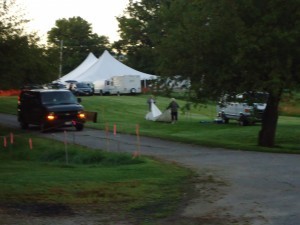
Vans arriving at show grounds
Shadows at the Spring Show. And Shadows at the Fair, the first book in the series, takes place entirely over one weekend, at a show.
Today I thought I’d give you an idea of what “doing a show” means to dealers.
I started preparing for last week’s show 3 days ahead. I sorted through our inventory, selected what we would take to display on our tables and in our floor easel, and what we would hang on the portable walls we’d take with us. Then I checked to make sure everything was priced (correctly!) and printed out new signs for about fifty prints that had been in a special exhibit last year and needed to be re-signed. I checked on-line for current prices for several of the prints we hadn’t taken out lately, or ever, and were going to hang. I made sure we had change for our cash box, an optimistic stack of sales slips, enough bags for sold items, and current business cards.
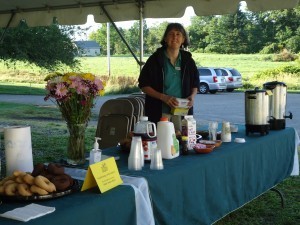
MAD Supplied Breakfast
The day before the show we packed our van. Walls and easels and a box of my books first. Then portfolios and framed items. On top, wire and wooden racks, table covers, cash box, “bag of bags” for sold items, small picture or book stands, and tools.
The morning of the show we set the alarm for 4. We had household chores to take care of, and then we headed out. By a little after 5:30 in the morning we were at the show location. About 70 dealers were doing this show. Most of them had booths outside in tents provided by MADA, or outside in their own tents or … just outside on the grass. Since (like Maggie) we don’t do outside shows, our booth was in the barn. The tables we’d pre-ordered with our booth rent were waiting for us in our space. Other than the tables dealers had ordered, the (beautiful) barn was empty.

One side of our booth
It didn’t stay that way long. Vans and trucks started rolling in. High school students looking to earn extra money by portering for dealers wandered around. Everyone tried to get their vehicles as close as possible to their booth location. As soon as one van emptied its owner moved it so another could fill its space.
At this show, the wonderful staff of the Maine Antique Digest (nationally, one of the best trade publications) set up a coffee, tea, juice and donuts station to welcome dealers. Refreshments were supplied by MAD.
People exchanged greetings as they carried in heavy furniture, paintings, trade signs, boxes of books and china, maritime antiques, rugs and linens … all sorts of antiques. But now wasn’t the time for long discussions. Now was the time to set up.
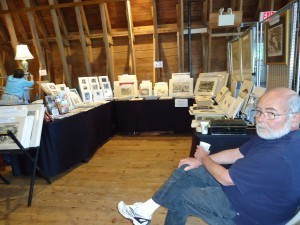
Bob, awaiting customers
By 8:00 most dealers had everything in place and began roaming the show grounds, searching for pre-show bargains. Inventory items changed hands, and were re-priced and placed in different booths. Customers were “let in” at 9:00.
The morning was, typically, very busy .. crowds of people looking, looking, commenting, and, we all hoped, buying.
Lunch? No free lunch. Some dealers brought their own. But the Damariscotta River Grill provided a chef and two servers to sell hot dogs, lobster rolls, chicken or vegetarian sandwiches. Customers ate at picnic tables under a tent. Dealers took their lunches back to their booths.
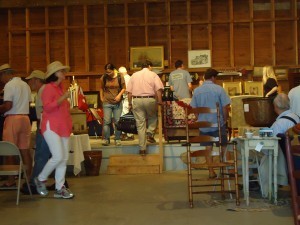
Customers!
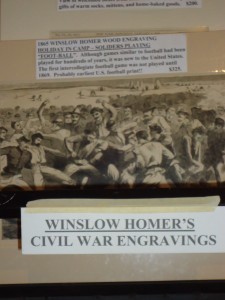
Winslow Homer Engravings?
By 2:00 the crowds had thinned out. Dealers started chatting with each other, discussing recent shows and auctions (good? better than last year? a total bust?) and their personal lives. (Daughter married? New baby? Husband having surgery? Retired from ‘day job’?) Everyone was tired. Some had gotten up at midnight and then driven two to four hours to get to the show. Others, like us, were luckier: we lived locally.

Fish, Anyone?
Pack-out began at 4:00. By 5:00 most dealers had filled their vans .. hopefully with fewer items than they’d brought in the morning … and headed out.
Now, all that was left was to unpack everything, do the accounts, and talk about whether to do the show again next year ….
See you there?
August 24, 2014
La Police Parisienne
When a felon’s not engaged in his employment
Or maturing his felonious little plan
His capacity for innocent enjoyment
Is just as great as any honest man
Lyrics from A Policeman’s Lot, The Pirates of Penzance
 Hi. Barb here and if all goes according to plan, when this blog goes live I’ll be winging my way across the Atlantic, coming home from a fabulous two and a half weeks in Paris.
Hi. Barb here and if all goes according to plan, when this blog goes live I’ll be winging my way across the Atlantic, coming home from a fabulous two and a half weeks in Paris.
We had a marvelous vacation. Partly because, due to the kindness of both friends and strangers, we stayed in a wonderful apartment on the Left Bank, just behind the plaza of the Musee D’Orsay. And partly because we’ve been in Paris three times in the last twelve years, so the list of “must sees” has dwindled. That, and fantastic weather, freed us up to explore more nooks and crannies of this beautiful city.
As a part MCW’s continuing meditation on whether a crime writer can ever really take a vacation, while we were in Paris, we visited the Musee de la Prefecture de Police. We went because our guide on one of the marvelous Paris Walks recommended it, and partly because we’re both crime writers, so we’re interested.
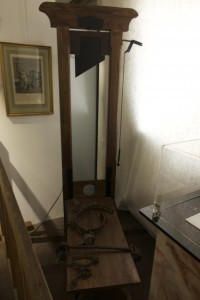
The guillotine remained the official means of execution in France until the death penalty was outlawed in 1981. The last execution by guillotine was in 1977.
The museum is on the second floor of a large police station in the Latin Quarter. Our Paris Walks guide had said it was “lightly trafficked” and I suppose it was compared to the hours-long lines at the Louvre or Eiffel Tower, but there was a steady stream of people there, both French and tourists when we visited.
History: In 1254, Louis IX, commonly known now as Saint Louis, founded the night Watch and the night Watch knights. Their motto, “He’s watching, so they rest,” is still the motto of the Paris prefecture. In 1725, the Paris police outlawed double parking and ordered the registration of carriages. All this makes the Paris police seem old and established, but the experience of the museum was quite different. In a city roiled time and again by revolution, invasion and occupation, where the government kept changing and with it the management of the police, the departments history felt tumultuous.
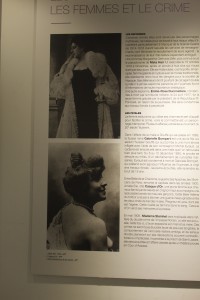
Remember the ladies–who also can be criminals. This poster talks about some of the famous ones–among them Mata Hari, who’ll turn up again in my post for the Wicked Cozy Authors this Thursday.
Vidocq: Francois Vidocq (1775-1857), an ex-prisoner (multiple times) and army deserter (multiple times) eventually became a police informer and from there he became the founder of the first police undercover squad in Paris. He was known for the extensive files he kept, his mastery of disguise, his photographic memory and his relentless pursuit of criminals and prison escapees. As the political winds changed, he became a founder of a paper company that employed mostly ex-convicts and, later, the founder of the first private detective agency. He is considered by many to be the father of modern criminology and was a model for both Jean Valjean and Inspector Javert in Les Miserables, as well as many other characters in literature.
Picaud: Pierre Picaud was a shoemaker from Nimes who moved to Paris and prepared to marry a wealthy woman. Three jealous friends falsely accused him of being a spy for England on the morning of his wedding. He was tried and imprisoned. A dying cellmate bequeathed him a hidden treasure. Picaud returned to Paris and spent ten years plotting and carrying out revenge against the friends who denounced him. A fourth friend, who knew of the false accusations and did nothing to stop them, finally killed Picaud. The friend’s deathbed confession formed the basis for the story which was published in 1838 by Jacques Peuchet, a French police archivist. This story was the inspiration for Alexander Dumas’, The Count of Monte Cristo.
 Note: Both of the above stories, and dozens of others, are brilliantly told in Parisians: An Adventure History of Paris by Graham Robb, a book I read just before we left on our vacation.
Note: Both of the above stories, and dozens of others, are brilliantly told in Parisians: An Adventure History of Paris by Graham Robb, a book I read just before we left on our vacation.
Overall, Bill and I quite enjoyed our visit to the museum, a short and stop as we get to know this beautiful city.
August 22, 2014
Weekend Update: August 23-24, 2014
 Next week at Maine Crime Writers there will be posts by Barbara Ross (Monday), Vicki Doudera (Tuesday), Lea Wait (Wednesday), James Hayman (Thursday), and Al Lamanda (Friday).
Next week at Maine Crime Writers there will be posts by Barbara Ross (Monday), Vicki Doudera (Tuesday), Lea Wait (Wednesday), James Hayman (Thursday), and Al Lamanda (Friday).
In the news department, here’s what’s happening with some of us who blog regularly at Maine Crime Writers:
Lea Wait: Saturday, August 23, I’ll be speaking about my Shadows on a Down East Summer, in which Winslow Homer is a major character, at The Yarn Seller, 264 Route 1, York Maine, at 11 a.m. I’ll be bringing a few Homer wood engravings for “show and tell,” and will have copies of all my books available for purchase.
From the Kathy Lynn Emerson half of Kathy/Kaitlyn: I have news of another sort. Awhile back I wrote about 100 pages of what was supposed to be an Elizabethan thriller with (alleged) witches. It really didn’t work as a novel, but out of that 100 pages, I recycled two short stories about Old Mother Malyn, the local herb woman, and her granddaughter Joan. “The Blessing Witch” and “The Cunning Woman” both take place in 1570 and I’ve had the very good luck to find homes for both of them. “The Blessing Witch” will be in the next New England anthology, Rogue Wave, which will be published in November. “The Cunning Woman” has just been accepted by Alfred Hitchcock Mystery Magazine. No publication date yet on that one. The moral: no writing is ever wasted. Heck, if I really look, there may be one or two more short stories in that 100 pages.
An invitation to readers of this blog: Do you have news relating to Maine, Crime, or Writing? We’d love to hear from you. Just comment below to share. Don’t forget that comments are entered for a chance to win our wonderful basket of books and the very special moose and lobster cookie cutters.
And a reminder: If your library, school, or organization is looking for a speaker, we are often available to talk about the writing process, research, where we get our ideas, and other mysteries of the business. Contact Kate Flora: mailto: kateflora@gmail.com
August 21, 2014
The Use of Force Continuum
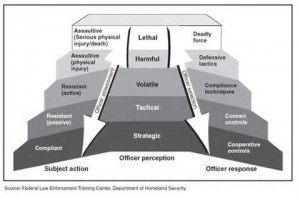 Kate Flora here, writing today about the use of force continuum, which will be explained, a bit, in the Wikipedia excerpts below. Before I became a crime writer, I thought that what writers did was to sit at their desks, exercise their imaginations, and make things up. But whether I’m writing cops as my main characters–as in the case of my Joe Burgess series, or a civilian, or amateur detective, as I do in my Thea Kozak series, there are many instances in which I need to know how the police function, and knowing when an officer can fire a gun is part of that.
Kate Flora here, writing today about the use of force continuum, which will be explained, a bit, in the Wikipedia excerpts below. Before I became a crime writer, I thought that what writers did was to sit at their desks, exercise their imaginations, and make things up. But whether I’m writing cops as my main characters–as in the case of my Joe Burgess series, or a civilian, or amateur detective, as I do in my Thea Kozak series, there are many instances in which I need to know how the police function, and knowing when an officer can fire a gun is part of that.
At some point, several years ago, I met a police officer at the gym, and started peppering him with 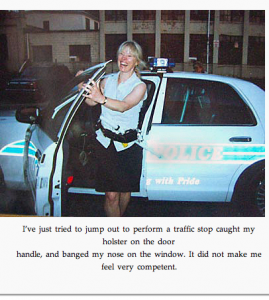 questions. His response was to encourage me to attend a citizen’s police academy. Since my town didn’t offer one, he arranged for me to attend the one in the city where he worked. One night, part of the lecture on patrol procedure was on the use of force continuum…that system cops use to assess what level of force is appropriate, and necessary, in any given situation. I don’t remember what they told us about some of the less threatening situations, but I clearly remember the scenario where someone is coming at you with a knife, and they asked: At what point do you draw your weapon? At twenty feet, they told us, the knife-wielding assailant can get to you before you can get your gun out of your holster.
questions. His response was to encourage me to attend a citizen’s police academy. Since my town didn’t offer one, he arranged for me to attend the one in the city where he worked. One night, part of the lecture on patrol procedure was on the use of force continuum…that system cops use to assess what level of force is appropriate, and necessary, in any given situation. I don’t remember what they told us about some of the less threatening situations, but I clearly remember the scenario where someone is coming at you with a knife, and they asked: At what point do you draw your weapon? At twenty feet, they told us, the knife-wielding assailant can get to you before you can get your gun out of your holster.
Something else they told us, which has stayed in my mind ever since, is that that officer, in a dangerous situation, wants to go home alive at the end of the shift.
I’ve been thinking about that a lot lately, because of the events in Ferguson. Because they’re talking  about convening a grand jury way before they can possible have gathered the essential facts. Because there is so much angry talk about shooting an unarmed boy dead in the street when a detailed assessment of the situation is very complicated. I’ve been thinking about some of the videos police officers have shown me, and about how incredibly fast these things happen.
about convening a grand jury way before they can possible have gathered the essential facts. Because there is so much angry talk about shooting an unarmed boy dead in the street when a detailed assessment of the situation is very complicated. I’ve been thinking about some of the videos police officers have shown me, and about how incredibly fast these things happen.
I’ve also been thinking about my husband’s question–a question that seems to have been fueled by watching too many westerns where the sharpshooter zaps the gun out of the bad guy’s hand. And about what we’ve been told when crime writers go shooting with the cops–always aim for center mass. If you’re at the point where you’re going to shoot, you want them to go down and stay down. Try for an arm or a leg and the person might not go down. Or stay down. Never mind how truly difficult it is to aim and fire under stress or to hit a moving target. So no, dear, if you’re at the point where you’re going to shoot, you’re shooting to stop that person.
So here’s a brief discussion of the use of force continuum, plus a bit from the Supremes on what the after the fact test is.
From Wikipedia:
A use of force continuum is a standard that provides law enforcement officials & security officers (such as police officers, probation officers, or corrections officers) with guidelines as to how much force may be used against a resisting subject in a given situation. In certain ways it is similar to the military rules of engagement. The purpose of these models is to clarify, both for officers and citizens, the complex subject of use of force by law officers. They are often central parts of law enforcement agencies’ use of force policies. Although various criminal justice agencies have developed different models of the continuum, there is no universal standard model.
The first examples of use of force continuum were developed in the 1980s and early 1990s. Early models were depicted in various formats, including graphs, semicircular “gauges“, and linear progressions. Most often the models are presented in “stair step” fashion, with each level of force matched by a corresponding level of subject resistance, although it is generally noted that an officer need not progress through each level before reaching the final level of force. These progressions rest on the premise that officers should escalate and de-escalate their level of force in response to the subject’s actions.
Although the use of force continuum is used primarily as a training tool for law officers, it is also valuable with civilians, such as in criminal trials or hearings by police review boards. In particular, a graphical representation of a use of force continuum is useful to a jury when deciding whether an officer’s use of force was reasonable.
The United States Supreme Court, in the case of Graham v. Connor, 490 U.S. 386, (1989), held that when engaged in situations where the use of force is necessary to effect an arrest, or to protect an officer’s life or that of another, a law enforcement officer must act as other reasonable officers would have acted in a similar, tense, rapidly evolving situation.[6] Such situations, once known as use of force incidents, are now commonly referred to as response to resistance incidents, because a law enforcement officer must respond to resistance offered by another. In order to determine what actions officers find reasonable in similar situations, some experts utilize surveys with law enforcement officers, who are provided with certain scenarios to determine what actions they would take if placed in certain situations. Experts such as Samuel Faulkner, former instructor at the Ohio Peace Officer Training Academy, not only surveys police officers, he has spoken to and surveyed, civilian review boards, high school and college government classes, Rotary Club and Kiwanis Clubs, Optimist Clubs, emergency managers, and even some chapters of the ACLU. Knowing what other officers and citizens deem reasonable helps to craft a solid response to resistance continuum.[7]
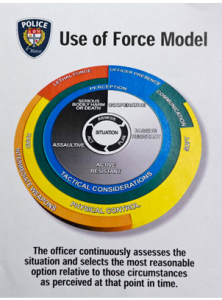 And one thing I’ve learned, by spending some hours today reading up on this, is that there is a movement now from the step-like format of the continuum to a use of force wheel, and much discussion about whether having to analyze the steps in an escalating situation might be seriously detrimental to officer safety.
And one thing I’ve learned, by spending some hours today reading up on this, is that there is a movement now from the step-like format of the continuum to a use of force wheel, and much discussion about whether having to analyze the steps in an escalating situation might be seriously detrimental to officer safety.
August 20, 2014
In Other News…
 Hello again from Sarah Graves, writing to you from Eastport, Maine, where if the world ends today we won’t find out about it for ten years or so, that’s how remote we are here. But we’re finding out plenty about one thing, all right: Now that CNN, MSNBC, and the other US “news” sources have discovered the intensely profitable clickbait that is Ferguson, MO, you’d think Ebola had been wiped out. Or that Israel and Gaza had made peace. Or that ISIS had decided to write children’s books. Or that…
Hello again from Sarah Graves, writing to you from Eastport, Maine, where if the world ends today we won’t find out about it for ten years or so, that’s how remote we are here. But we’re finding out plenty about one thing, all right: Now that CNN, MSNBC, and the other US “news” sources have discovered the intensely profitable clickbait that is Ferguson, MO, you’d think Ebola had been wiped out. Or that Israel and Gaza had made peace. Or that ISIS had decided to write children’s books. Or that…
Never mind, you get the idea. It’s all Ferguson all the time right now, at least in part, perhaps, because the news media folks think we all need to get with the program and start talking about this stuff, seeing it and knowing about it and maybe even doing something about it. (Which is what I think, in case that’s not clear.) But there’s a chance it’s also because they’ve figured out that people will watch live feeds of any kind of conflict, especially if there are guns and tanks in the picture and a chance of their being used. ‘If it bleeds, it leads,’ is still true, after all, and it’s true for a reason: the more people are watching, the more ads the network can sell, and the more they can charge for the ads.
media folks think we all need to get with the program and start talking about this stuff, seeing it and knowing about it and maybe even doing something about it. (Which is what I think, in case that’s not clear.) But there’s a chance it’s also because they’ve figured out that people will watch live feeds of any kind of conflict, especially if there are guns and tanks in the picture and a chance of their being used. ‘If it bleeds, it leads,’ is still true, after all, and it’s true for a reason: the more people are watching, the more ads the network can sell, and the more they can charge for the ads.
So that’s another reason why we’re seeing so much of it, in my opinion.  And since I have it on fairly good authority that the poor we shall always have with us, the strategy of profiting off conflicts that arise out of economic (and other kinds of) inequality will stick around for a while, too, probably. Or anyway it will as long as the “barrier” between advertising and editorial is so…well, I was about to say non-existent, but let’s be charitable and call it porous.
And since I have it on fairly good authority that the poor we shall always have with us, the strategy of profiting off conflicts that arise out of economic (and other kinds of) inequality will stick around for a while, too, probably. Or anyway it will as long as the “barrier” between advertising and editorial is so…well, I was about to say non-existent, but let’s be charitable and call it porous.
Or we could talk about volcanoes. As luck would have it, there’s one worth talking about right now, called Bardarbunga. It’s in Iceland, way the heck out in the sticks (which most of Iceland is, actually) under a glacier called Vatnajokull, and over the past week or so there’ve been earthquakes around it. Lots and lots of earthquakes, 2600 or so, in fact, enough to make the geologists think something’s about to go kablooey.
Last time an Icelandic earthquake went kablooey , in 2010, the ash in the atmosphere shut down a  large chunk of European air travel for ten days. If Bardarbunga should blow, however, it won’t necessarily create an ash cloud. It could just melt a sizable portion of the glacier and cause a huge flood. People are already being evacuated from around the volcano, although at this point it’s only a precaution, so don’t worry. If enormous red-hot smoking boulders start flying out of the volcano called Bardarbunga, I’m sure the news media will let us know. Eventually.
large chunk of European air travel for ten days. If Bardarbunga should blow, however, it won’t necessarily create an ash cloud. It could just melt a sizable portion of the glacier and cause a huge flood. People are already being evacuated from around the volcano, although at this point it’s only a precaution, so don’t worry. If enormous red-hot smoking boulders start flying out of the volcano called Bardarbunga, I’m sure the news media will let us know. Eventually.
August 19, 2014
MYSTERY OF THE RHINE #3 – SOLVED!
Susan Vaughan here. This post will complete my summer vacation travelogue of Rhine mysteries. Why are there so many castles along the Rhine?
The morning of day four of our river journey, we went to Braubach and toured Marksburg Castle, the only Medieval castle on the Rhine to have survived intact. The oldest section, the inner keep, dates from about 1200. The great hall and the kitchen contain some of the original furnishings.
In the afternoon, we cruised on upriver. Seen from a cruise ship’s deck, the Middle Rhine seems like a journey through history.
In rapid succession, we gawped at a pageant of vineyards, walled towns, and hills topped with castles.
The ship’s program director announced their names, along with tidbits of history. Even though I still have the map and my photos, I cannot say for sure which castle is which. Ones I remember were the Sterrenberg and Liebenstein castles, owned by brothers who hated each other, so the pair were called the Hostile Brothers.
Thurnburg, or Burg Maus (Mouse Castle), gets its nickname for its diminutive size compared to Neu-Katzenelnbogen, or Burg Katz (Cat Castle). I can’t guarantee my photos match those names. Most of the many castles we saw were ruins, some only a tower and others a few walls.
Centuries of European wars and wars between rival nobles burned the wood and tumbled the stone. My binoculars picked out some potted geraniums and patio umbrellas, where enterprising contemporary owners had turned semi-ruins into B&Bs or restaurants.
The Lorelei is not a castle, but a fabled cliff which towers over a bend in the river, narrow at this point to 350 feet. Tricky currents and rocks spelled disaster to many ships and inspired German poets to invent the “Legend of the Lorelei,” which told of a beautiful girl whose seductive song lured mariners to their doom. A statue of her commemorates the legend.
So why all these castles, which by my count number at least 20 in about 40 miles? Kings had their royal palaces, but many other nobles built castles and fortresses along the Rhine in order to defend their lands and enrich themselves. Along this narrow stretch of river, with steep hillsides blocking the wind, ships often couldn’t sail without help from land—animals pulling them along on tow paths. Knights and barons could fire cannons down on ships and demand taxes or cargo for safe passage. The origin of the term “robber baron.” So there you have the answer.
*** My newest release is a box set of the Task Force Eagle trilogy for your Kindle, price reduced August 26-30. You can find excerpts and buy links at www.susanvaughan.com.
Lea Wait's Blog
- Lea Wait's profile
- 509 followers


